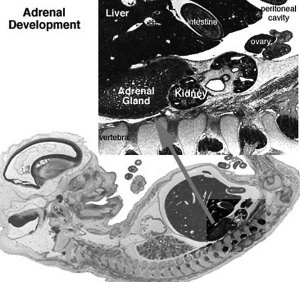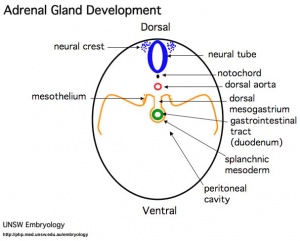Endocrine - Adrenal Development
Adrenal
The developing adrenal gland has both an interesting origin and an intruiging fetal role. Furthermore recent studies suggest that the adrenal cortex share a common embryonic origin with the early gonad. The adrenal gland and placenta also act in synergy, and the notes endocrine placenta should also be read.
The 2 adrenal glands (suprarenal gland, glandulæ suprarenales) are named by their anatomical postion sitting above the 2 kidneys (renal). The 2 main parts of the adrenals have different embryonic origins. The inside core adrenal medulla is neural crest in origin. Mesenchyme surrounding these cells differentiates to form a fetal cortex. This fetal cortex is later replaced by the adult cortex. The outside adrenal cortex is derived from mesothelium and can be further divided into 3 distinct layers (zona reticularis, zona fasiculata, zona glomerulosa) each with distinct hormonal functions.
During fetal development, adrenal hormones are involved with the maturation of the lung and other developing systems.
| Lecture - Neural Crest Development | original page
- Richly vascularized - arterioles passing through cortex, capillaries from cortex to medulla, portal-like circulation
- Fetal Cortex - produces a steroid precursor (DEA), converted by placenta into estrogen
- Adult Medulla - produces adrenalin (epinephrine), noradrenaline (norepinephrine)
- Fetal adrenal hormones - influence lung maturation
Adrenal cortical hormones - (steroids) Cortisol, Aldosterone, Dehydroepiandrosterone
- zona glomerulosa - regulated by renin-angiotensin-aldosterone system controlled by the juxtaglomerular apparatus of the kidney.
- zona fasciculata - regulated by hypothalamo-pituitary axis with the release of CRH and ACTH respectively.
Adrenal medullary hormones - (amino acid derivatives) Epinephrine, Norepinephrine
Some Recent Findings
- Development of the human adrenal zona reticularis: morphometric and immunohistochemical studies from birth to adolescence. Hui XG, Akahira J, Suzuki T, Nio M, Nakamura Y, Suzuki H, Rainey WE, Sasano H. J Endocrinol. 2009 Nov;203(2):241-52. Epub 2009 Sep 1. PMID: 19723922
- "Results demonstrated that ZR became discernible around 4 years of age, and both thickness and ratio per total cortex of ZR increased in an age-dependent fashion thereafter, although there was no significant increment in total thickness of developing adrenal cortex. We further evaluated immunoreactivity of both KI67 and BCL2 in order to clarify the equilibrium between cell proliferation and apoptosis in the homeostasis of developing human adrenals. Results demonstrated that proliferative adrenocortical cells were predominantly detected in the zona glomerulosa and partly in outer zona fasciculata (ZF) before 4 years of age and in ZR after 4 years of age, but the number of these cells markedly decreased around 20 years of age."
Adrenal Development
- Fetal Adrenals - fetal cortex later replaced by adult cortex
- Week 6 - fetal cortex, from mesothelium adjacent to dorsal mesentery; Medulla, neural crest cells from adjacent sympathetic ganglia
- Adult cortex - mesothelium mesenchyme encloses fetal cortex
Adrenal Cortex
- Late Fetal Period - differentiates to form cortical zones
- Birth - zona glomerulosa, zona fasiculata present
- Year 3 - zona reticularis present
Endocrinology - Adrenal Cortex Development
Adrenal Medulla
- neural crest origin, migrate adjacent to coelomic cavity, initially uncapsulated and not surrounded by fetal cortex, cells have neuron-like morphology
- 2 cell types - secrete epinepherine (adrenaline) 80%; secrete norepinepherine (noradrenaline* 20%
Development Overview
Medulla - Neural crest cells migrate toward the coelomic cavity wall and form the adrenal medulla. These chromaffin (chromaphil) cells originally named because of their staining (yellow) with chromium salts. (More? [#Medulla Adrenal Medulla])
Cortex - Week 4 celomic epithelium (mesothelium) cells proliferate initially forming small buds that separate from the epithelium. Week 6 these now mesenchymal cells first form the fetal adrenal cortex which will be later replaced by the adult cortex. (More? [#Cortex Adrenal Cortex])
Adrenal Cortex
| File:Adrenalst22 sm.jpg | File:Adrenal1.gif |
| Human embryo (7 weeks, stage 22) adrenal gland showing the fetal and permanent adrenal cortex. Note that the medulla of the adrenal gland is not yet encapsulated by the cortex. | Human fetus (10 week, 40mm, parasagittal section) shows location of the developing adrenal gland. The spongy appearance at the centre of the adrenal is the degenerating fetal cortex. The dense region around the outside of the adrenal is the developing adult cortex. (More? [../wwwhuman/Hum10wk/HumA.htm Human Fetus (10 week)]) |
Week 4 - coelomic epithelium (mesothelium) cells proliferate initially forming small buds that separate from the epithelium.
Week 6 - these now mesenchymal cells surrounding the developing medulla cells differentiate first form the fetal adrenal cortex which will be later replaced by the adult cortex.
Week 8 to 9 - fetal adrenal cortex synthesizes cortisol and is maximal at 8-9 weeks post conception (wpc) under the regulation of ACTH (also stimulates androstenedione and testosterone secretion).[1]
Adult cortex - mesothelium mesenchyme encloses fetal cortex.
Late Fetal Period - differentiates to form cortical zones.
Birth - zona glomerulosa, zona fasiculata present.
Year 3 - zona reticularis present.
Fetal Cortex
Fetal adrenal cortical growth involves several cellular processes: hypertrophy, hyperplasia, apoptosis, and migration.
In the second and third trimesters a steroid precursor (DEA) and sulphated derivative (DHEAS) which is converted by placenta into estrogen.
Three functional zones:
- fetal zone - throughout gestation expresses enzymes required for DHEA-S synthesis.
- transitional zone - initially identical to the fetal zone but later (after 25-30 weeks) expresses enzymes that suggest glucocorticoid synthesis.
- definitive zone - after 22-24 weeks expresses enzymes that suggest mineralocorticoid synthesis.
Adult Cortex
Reticularis - narrow band, many small cells and capillaries androgens.
Fasiculata - high lipid content, pale foamy cells cortisol, corticosterone, cortisone.
Glomerulosa - small cells, cords or oval groups, aldosterone.
Abnormalities
Congenital Adrenal Hyperplasia (CAH)
A family of inherited disorders of adrenal steroidogenesis enzymes which impairs cortisol production by the adrenal cortex.
Enzymes most commonly affected: 21-hydroxylase (21-OH), 11beta-hydroxylase, 3beta-hydroxysteroid dehydrogenase.
Enzymes less commonly affected: 17alpha-hydroxylase/17,20-lyase and cholesterol desmolase.
Classical CAH - androgen excess leads newborn females with external genital ambiguity and postnatal progressive virilization in both sexes. (More? [genital.htm Genital Notes] | [genital2.htm Genital Abnormalities])
Pheochromocytomas (PCC)
Catecholamine-producing (neuro)endocrine tumor located in the adrenal medulla. Similar catecholamine-producing tumors outside the adrenal gland are called paragangliomas (PGL).
Cushing's syndrome
(hypercortisolism) A relatively rare metabolic hormonal disorder caused by prolonged exposure of the body’s tissues to high levels of the adrenal hormone cortisol, most commonly affects adults aged between 20 to 50 and also the obese with type 2 diabetes. (More? NIH - NIDDK)
Genes
- SoxE - Sry-box (Sox)8, and Sox10 are expressed in the neural crest and in neural crest cells migrating to the adrenal gland.[2]
- SF-1 - Steroidogenic factor 1 an orphan nuclear receptor
- DAX1
- CYP17
References
Online Textbooks
Endocrinology: An Integrated Approach Nussey, S.S. and Whitehead, S.A. Oxford, UK: BIOS Scientific Publishers, Ltd; 2001. 4.7. Embryology of the adrenal gland | The Adrenal Gland | Anatomical and functional zonation in the adrenal cortex
Developmental Biology (6th ed) Gilbert, Scott F. Sunderland (MA): Sinauer Associates, Inc.; c2000. Figure 13.6. Final differentiation of a trunk neural crest cell committed to become either an adrenomedullary (chromaffin) cell or a sympathetic neuron
Molecular Biology of the Cell (4th Edn) Alberts, Bruce; Johnson, Alexander; Lewis, Julian; Raff, Martin; Roberts, Keith; Walter, Peter. New York: Garland Publishing; 2002. table 15-1. Some Hormone-induced Cell Responses Mediated by Cyclic AMP | Cells Can Respond Abruptly to a Gradually Increasing Concentration of an Extracellular Signal
Health Services/Technology Assessment Text (HSTAT) Bethesda (MD): National Library of Medicine (US), 2003 Oct. Adrenal Gland search Results
Search NLM Online Textbooks- "adrenal development" : Endocrinology | Molecular Biology of the Cell | The Cell- A molecular Approach
Reviews
- The adrenal cortex and sexual differentiation during early human development. Asby DJ, Arlt W, Hanley NA. Rev Endocr Metab Disord. 2009 Mar;10(1):43-9. Review. PMID: 18670886
- Disorders of adrenal development. Ferraz-de-Souza B, Achermann JC. Endocr Dev. 2008;13:19-32. Review. PMID: 18493131
- Hanley NA, Arlt W. The human fetal adrenal cortex and the window of sexual differentiation. Trends Endocrinol Metab. 2006 Dec;17(10):391-7.
- Huber K. The sympathoadrenal cell lineage: specification, diversification, and new perspectives. Dev Biol. 2006 Oct 15;298(2):335-43.
- Yanase T, Gondo S, Okabe T, Tanaka T, Shirohzu H, Fan W, Oba K, Morinaga H, Nomura M, Ohe K, Nawata H. Differentiation and regeneration of adrenal tissues: An initial step toward regeneration therapy for steroid insufficiency. Endocr J. 2006 Aug;53(4):449-59.
- Jaffe RB, Mesiano S, Smith R, Coulter CL, Spencer SJ, Chakravorty A. The regulation and role of fetal adrenal development in human pregnancy. Endocr Res. 1998 Aug-Nov;24(3-4):919-26.
- Mesiano S, Jaffe RB. Developmental and functional biology of the primate fetal adrenal cortex. Endocr Rev. 1997 Jun;18(3):378-403.
Articles
<pubmed>20010965</pubmed> <pubmed>19723922</pubmed> <pubmed>17537799</pubmed> <pubmed>16585961</pubmed> <pubmed>16093324</pubmed> <pubmed>11319516</pubmed> <pubmed>9888597</pubmed>"The rapid growth of the human fetal adrenal gland, which is primarily a reflection of the growth of the unique fetal zone, is regulated by ACTH acting indirectly to stimulate the expression of locally produced growth factors, of which IGF-II and bFGF appear to play key roles. Through most of gestation, the outer definitive zone appears to function as a reservoir of progenitor cells which move centripetally to populate the rest of the gland. At the end of pregnancy, the fetal zone undergoes senescence through an apoptotic process. Activin and TGF-beta are capable of inducing apoptosis in the fetal zone. Corticotropin-releasing hormone, which is produced by the placenta in markedly increased amounts at the end of gestation, may orchestrate a variety of processes, including direct stimulation of fetal adrenal steroidogenesis, culminating in the initiation of parturition."
Search PubMed
Search April 2010
- Adrenal Development - All (646) Review (52) Free Full Text (84)
- Congenital Adrenal Hyperplasia - All (2091) Review (211) Free Full Text (314)
Search Pubmed: adrenal development | Congenital Adrenal Hyperplasia
Additional Images
Adult Histology
Terms
Glossary Links
- Glossary: A | B | C | D | E | F | G | H | I | J | K | L | M | N | O | P | Q | R | S | T | U | V | W | X | Y | Z | Numbers | Symbols | Term Link
Cite this page: Hill, M.A. (2024, May 2) Embryology Endocrine - Adrenal Development. Retrieved from https://embryology.med.unsw.edu.au/embryology/index.php/Endocrine_-_Adrenal_Development
- © Dr Mark Hill 2024, UNSW Embryology ISBN: 978 0 7334 2609 4 - UNSW CRICOS Provider Code No. 00098G




